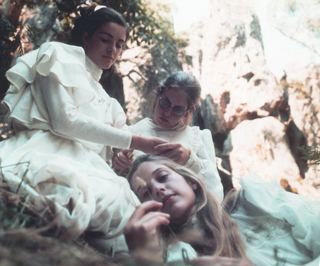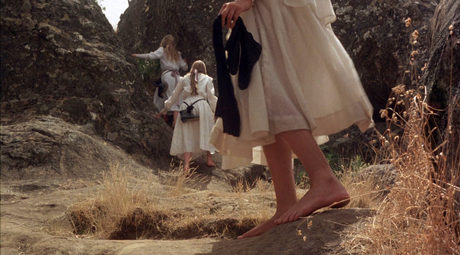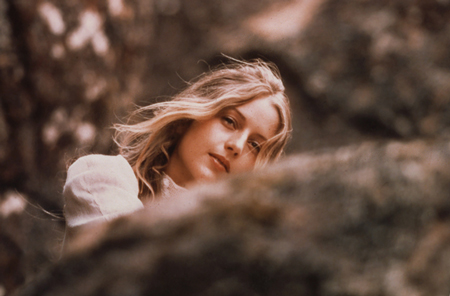Reviewed by Glenn Erickson
Picnic at Hanging Rock is an Australian art film about a strange episode in the past that creates a tangible aura of mystery while perpetuating various myths about the 'sexual awakening' of young girls. Beautiful to look at, it uses a bizarre incident as an opportunity to explore the weaknesses of Australian society at the turn of the century. In all other respects it's a subdued and prettified horror film at a prim and proper school for girls, where most of the shocks and horror occur off-camera. The first shot accompanies an image of Hanging Rock with an ominous hum on the soundtrack. In post- The Exorcist terms, this triggers associations with The Devil at work. Director Peter Weir takes pains to pack the dialogue with references to sexual repression and supernatural intervention. The overall tone is one of quiet hysteria.
Criterion's disc is the answer to viewers that were equally fascinated and dumbfounded by the film when was new. Will close examination yield new clues to the mystery? After pondering the many extras, everything about Weir's movie becomes clear --- except what happened to the characters that seemingly vanished in broad daylight.
Australia, 1900. A wagonload of private school girls takes a day trip to Hanging Rock, a picnic destination of middling interest. Given permission by their French teacher Mademoiselle de Portiers (Helen Morse) to snoop around the base of the rock, four of them wander upward into the higher elevations of this outcropping. They disappear into the rocks, along with a teacher who follows on her own to retrieve them. Multiple searches turn up nothing. This cripples activity at the school. Parents withdraw some of the students, and one of the remaining teachers quits. The headmistress Mrs. Appleyard (Rachael Roberts) sees the end of the business she's worked all her life to build. Over a week later two local boys go back to the rock to cover search ground already gone over a dozen times...

A major curiosity of a movie, Picnic at Hanging Rock is one of the earliest of the "New Australian" pictures of the seventies that made it big in the American market, or at least earned wide distribution. The film had to wait four years for this release, in 1979, after director Peter Weir had made a hit with The Last Wave, a quasi-mystical courtroom drama that also suggested that ancient supernatural powers held sway over the vast continent of Australia. Weir's previous film was The Cars that Ate Paris, an apocalyptic satire that must have been an inspiration for the Mad Max movies, but remained fairly obscure. At what many consider a great time for films in America, when abstract narrative puzzles like Nicolas Roeg's The Man Who Fell to Earth were well-received, Hanging Rock stirred up a lot of discussion. First, it was beautiful to look at. Second, even readers of the Joan Lindsay source novel believed the story to be based on a true incident. And third, the movie generated endless talk about possible 'solutions' for its ambiguous mystery.
Discussing Picnic at Hanging Rock requires the employment of many SPOILERS. Beware.
So what happens, and what does it mean? If we're sticking to the facts, four females disappear on this picnic. One is found, much later in a condition totally out of keeping with the length of time she was missing. Reconstructing the sequence of events is clouded by the emotions of the searchers and the inability of the recovered girl to remember anything. The only thing known about the spinsterish teacher who went up the hill supposedly to retrieve the girls (Miss McCraw, played by Vivean Gray) is that she was last seen wearing only her pantaloon underwear, and not the heavy skirts these turn of the century maidens were corseted into.
The poor constable on the case has little of substance to work with. The account of the girls' actions while out on their own is based on the hardly reliable testimony of a surviving fourth girl (the complaining Edith, played by Christine Schuler). When the soon-to-vanish wordlessly remove their shoes and stockings and hike barefoot further into the rocks, they utterly disappear without any rational explanation. The rest is rumor and illusion, coupled with the kind of "clues" that might show up in a supernatural or science fiction story. Here's the rundown:
The beautiful, fair-haired Miranda (Anne Lambert) has a strong emotional connection with her roommate, the orphan Sara (Margaret Nelson). As it is Valentine's Day the girls are quoting love poetry, and some of them talk in poetic bliss. This makes them seem all the more suitable to play virgin sacrifices in a fairy tale or horror story. Miranda makes the strange statement to her roommate Sara (Margaret Nelson) that she'll not be around long, which in the context of the film foretells her doom.
Instructor Mlle. de Poitiers (Helen Morse) compares Miranda to a 'Botticelli angel' as she watches the girl wander away. In their beautiful costumes, seemingly already abstractions of feminine youth from an innocent age past, Miranda and her friends do seem like objects of abstract beauty, removed from time and reality. Were they 'artistically idealized' to death? Or are they such potent symbols of sensual promise that the Hanging Rock absorbed them, like a voracious spirit of nature?
Miss McCraw is shown examining a book of Geometry, but we never see her leave the napping picnic party. We only have Edith's word that she later went up the hill in her knickers. The wagon driver can confirm that more than one pocket watch stopped at exactly 12 noon, however. That sort of clue often indicates that a natural cataclysm is about to take place -- or that outer space Aliens have exerted a magnetic field over the area. The visuals keep suggesting that something supernatural has taken place. More than one person says that the girls could have fallen down a hole, but even that explanation isn't particularly believable.

The two boys' exact actions are not immediately known. The rich Michael (Dominick Guard) is smitten by the sight of the girls crossing a stream, and follows them. Servant Albert Crundall (John Jarratt) is a strong lad with a more vulgar appraisal of the women. After Michael leaves, we don't know what he gets up to. Later on, both seem honestly innocent, and become obsessed with a desperate rescue. Found shivering on the hill, Michael's delirium doesn't explain the tatter of a girl's dress clutched in his hand, or why her body appears in plain sight a while later, in a place almost certainly searched before. 2
The repressed attitude toward sex and sex crimes cuts off various avenues of investigation. People are obviously thinking about sordid scenarios, but are too timid to discuss them. There's a general hesitation to even think that these idealized female creatures could in any way be complicit in evil doings. If the mystic angle weren't advanced so strongly, it makes sense that a rapist-murderer or a kidnapper might have been involved. Or perhaps the girls wanted to run away and there was a conspiracy of silence. Perhaps Miss McCraw was secretly involved in something wicked with the girls. If we take the behavior of the girls at face value, none of these wild ideas seems likely. Although it is silly to think that Miss McCraw sold the girls into White Slavery, or that Michael and Albert captured them as sex slaves for a week, such theories are no less absurd than the supernatural one constantly suggested by Peter Weir and screenwriter Cliff Green.
Given no explanation for events, moviegoers will naturally scrutinize every detail of a film for clues. Alfred Hitchcock's The Birds was an education for literal-minded moviegoers, dropping hints at every turn to consider explanations for its unexplainable events. Peter Weir instead weaves a delicate web of markers pointing to the idea that Hanging Rock is a supernatural entity that has 'claimed' the girls, like a prehistoric God or a nature deity. Weird sounds abound and Michael hears echoed dialogue a week later. The girls' poetic musings, silent movements and ritual-like behavior make them seem like sacrificial victims. After the Aboriginal/Anglo clash of The Last Wave, most audiences in 1979 figured this was the only possible explanation for it all. Weir constructs long superimpositions of Miranda against the rock that make her seem to dissolve into the landscape. Much later, Michael sees a (daydream?) vision of Miranda in a garden. Weir's visuals equate her with a swan, as if she's now taken on a new role in nature. 1
Weir sticks to his theme of facts being essentially 'unknowable' and spends quite a bit of time documenting the sensuality of these beautiful virginal "creatures". In addition to the swans, he places demon-like lizards on Hanging Rock at crucial moments in the story, especially a break when the girls lie sleeping on flat rocks while ominous sounds are heard and heat waves distort the image. Protected and watched at all times, the schoolgirls live a weird cloistered life. They write valentines, quote poetry, have strong passions and yearn for sexuality itself. In their era, sensuality and the supernatural must have been equally mysterious -- both were whispered secrets denied by decent society.

Picnic at Hanging Rock is at its best when showing the depressing aftermath of the disaster: the panic and the frustration in the fruitless rescue missions. The camera lingers on the haunted reactions of the remaining girls. The fragile social structure cannot handle the shame and frustration of a mystery that refuses to be solved. The lack of resolution means ruin for the school. Socially speaking, more people 'disappear'. Teachers resign and pupils are sent away, some for reasons that are not publicly acknowledged. Sara is literally wiped out by the headmistress Mrs. Appleyard, as efficiently as the Hanging Rock erased her beloved Miranda. Sara had been denied the privilege of going on the picnic because her tuition hadn't been paid. When Mlle. de Poitier notices that Sara has disappeared, Mrs. Appleyard can't make herself tell the truth, and invents a story instead. Albert also lied about Michael's whereabouts when Michael spends the night at Hanging Rock, which makes us wonder how much of the incident was similarly invented or altered by its witnesses. As a poetic conceit Picnic at Hanging Rock is a smashing success. As a mystery it's a meaningful exercise in futility. As a sly comment on humans facing unpleasant truths, it is an impressive movie indeed. After this intimate picture of youthful female preoccupations, Peter Weir would move on to examine male youth's fascination with adventure and glory in his impressive Gallipolli.
Although Rachel Roberts is the name star of the show, Dominic Guard was well remembered from Joseph Losey's The Go-Between. Critics desperate to connect Hanging Rock with traditional film horror should note that the matron who praises a maid for suppressing a clue about a missing corset is Olga Dickie, the thoughtless maid from the Hammer classic Horror of Dracula.
Criterion's Dual-Format Blu-ray + DVD edition of Picnic at Hanging Rock is a great improvement over the old DVD release from 2001. The new HD transfer is formatted at 1:78 widescreen, and the increased detail can finally replicate the gauzy images of women wearing white in the afternoon heat.
The uncompressed 5.1 audio really brings out the creepy hums and rumbles signifying horrific forces at work, while reproducing the period songs well. The dubbing of some actors is more apparent, however. Somewhere along the line Peter Weir re-edited the film, dropping eight full minutes from its running time. For the seriously curious some foreign releases contain both cuts of the movie. A 2008 PAL DVD has been reviewed at DVD Savant by Lee Broughton.
The old DVD was lacking in extras, a condition remedied by disc producer Jason Altman. A lengthy promo film from 1975 discusses the mystery as if it were historically true, and has input from Rachael Roberts, director Weir and author Joan Lindsay. It's accompanied by a new making-of interview docu with the film's producers and some of the actors. In a long solo interview from 2003, Peter Weir goes into great detail about his approach to the film, and recounts what happened when he tried to pin down author Lindsay as to the story's events being factual or not.
An intro by author David Thompson brings up some good points, such as why Hanging Rock would have been considered a suitable place for a picnic at all, considering the dangers described by Mrs. Appleyard. That observation makes us wonder why the parents of the three missing girls don't immediately rush to the school, demanding action and threatening everyone in sight with lawsuits. It's to Weir's credit that these considerations don't derail his eerie fantasy.
In addition to an original trailer, we're given an okay transfer of Weir's early movie Homesdale, a bizarre fantasy about a holiday camp that seems to have been taken over by malicious maniacs. Guests are teased and the odd and weak ones tormented. A replay of a Psycho shower scene comes out of nowhere, as do later moments of absurd violence. Fifty minutes long and filmed in B&W, it seems designed for TV use. It may be director Weir's one stab at a commercial horror show.
Criterion's box also contains a paperback of Joan Lindsay's original novel, which we're told was out-of print in the United States. The Dual-Format release has one Blu-ray and two DVD discs; a second DVD-only release does not include the paperback book.
On a scale of Excellent, Good, Fair, and Poor,
Picnic at Hanging Rock Blu-ray + DVD
rates:
Movie: Excellent
Video: Excellent
Sound: Excellent
Supplements: Interview with Peter Weir; new making-of piece featuring interviews with executive producer Patricia Lovell, producers Hal McElroy and Jim McElroy, and members of the cast; Introduction by film scholar David Thomson; A Recollection . . . Hanging Rock 1900 (1975), an on-set documentary featuring Weir, actor Rachel Roberts and author Joan Lindsay; Peter Weir's 1971 black comedy Homesdale (1971); Trailer; Insert booklet containing an essay by author Megan Abbott and a book excerpt from film scholar Marek Haltof; a paperback edition of Lindsay's novel, previously out of print in the U.S. (Haltof piece and paperback in dual-format release only).
Deaf and Hearing-impaired Friendly?
YES; Subtitles: English
Packaging: One Blu-ray and two DVD discs with insert booklet and paperback novel in heavy card box.
Reviewed: July 6, 2014
Footnotes:
1. Remembering the documentary Burden of Dreams, I can mentally imagine filmmaker Werner Herzog throwing a tantrum at Peter Weir's fantasy image of "nature". Herzog would insist on reminding us that the swan eats disgusting bugs, or defecates all over the place, contributing to the oppressive rot and decay of natural reality.
Return
2. Had we seen Hanging Rock when it was new in 1975, we'd have been looking for the missing schoogirls during the 'returned lost people' scene at the end of Close Encounters of the Third Kind. A couple of women in period clothing are seen exiting the Mothership in silhouette, but they don't look quite right...
Return

Text © Copyright 2014 Glenn Erickson
See more exclusive reviews on the Savant Main Page.
The version of this review on the Savant main site has additional images, footnotes and credits information, and may be updated and annotated with reader input and graphics.
Return to Top of Page
|


